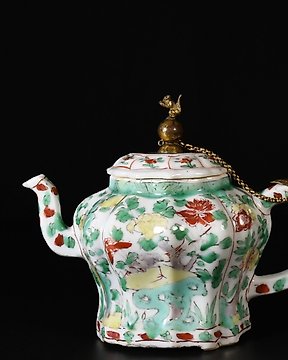
Théière - Théière en porcelaine aux émaux de la Famille Verte - Porcelaine
Nº 82983573

Nº 82983573

A very nicely made 18th century Qianlong Amsterdam Bont porcelain plate with a rare scene of stadholder Willem IV of Orange and his wife.
For similar examples see pictures, well documented in the literature these kind of European scenes.
We take a look at Amsterdams Bont porcelain from China. A relatively unknown niche of Chinese porcelain from ca 1680-1740 that was partly decorated in Europe. Because mainstream Chinese collectors have yet to discover the historical significance of these wares they are relatively easy to find in Holland. While also being highly interesting and of often super quality and with an amazing array of decorations. Amsterdams Bont is a name given to porcelain partly decorated in the Netherlands (most likely in cities like Delft, Haarlem, Makkum). Because Amsterdam was at this moment in time the trade centre of the western world and also of the porcelain trade a lot of this over enamelling was probably commissioned by Amsterdam merchants, to reap higher profits on otherwise boring Chinese wares. The name Amsterdam Bont probably derives from the fact that these type of decorated ware was sold by Amsterdam Merchants. Amsterdam Bont consists of either blanc or under glaze blue decorated Chinese porcelain of basic quality, that was later enhanced with red and sometimes other colours in the Netherlands. It must not be mistaken for other type of Chinese & Japanese blanc wares decorated in Europe. Those we simply call European Decorated Chinese porcelain. Amsterdam Bont really is easily recognisable by its colour and style. An interesting side note is that a similar process of overdecorating with red was done in London in more or less the same colours.
Method of manufacturing.
This enhancemend was done on “petit feux” or small fire at a lower temperature. This technique of baking enamels on a lower temperature that was perfected in the Delft around 1670-1680 to compete with the colourfull Japanese porcelain of the time. At the turn of the 17th c Chinese porcelain was cheaper than its Japanese counterpart and by overglazing Chinese porcelain with red it was easy for the Dutch to create a `Imari` feel on the Chinese wares. Catering to the huge craving for imari coloured porcelain in the West at the time. At that time blue _ white porcelain was relatively well known as was blue and white delftware. It was the addition of different colours that sparked huge interest. Everybody wanted porcelain with red in it, and that was what the merchants were giving their customers with this Amsterdam Bont decorations. One must imagine that sometimes a VOC ship brought home hundreds of thousands of pieces of porcelain, often with 1000’s of pieces decorated in the same way (See for example the Geldermalsen or “Nanking” Cargo) . So a simple blue and white bowl could easily be increased in value by enhancing its looks.
Condition
1 star hairline in base, also visible at front, some fritting. Size 225x25mm DiameterxHeight
Period
18th century Qing (1661 - 1912)
Comment acheter sur Catawiki ?
1. Découvrez des objets d’exception
2. Faites la meilleure offre
3. Effectuez un paiement sécurisé